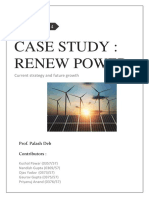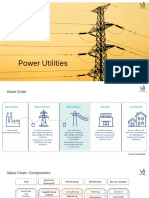Electricity Sector in India
Electricity Sector in India
Uploaded by
Rohit GoelCopyright:
Available Formats
Electricity Sector in India
Electricity Sector in India
Uploaded by
Rohit GoelCopyright
Available Formats
Share this document
Did you find this document useful?
Is this content inappropriate?
Copyright:
Available Formats
Electricity Sector in India
Electricity Sector in India
Uploaded by
Rohit GoelCopyright:
Available Formats
Electricity sector in India
From Wikipedia, the free encyclopedia
The electricity sector in India supplies the world's 5th largest energy consumer, accounting for 4.0% of global energy consumption by more than 17% of global population. the Energy policy of India is predominantly controlled by the Government of India's, Ministry of Power, Ministry of Coal and Ministry of New Renewable Energy and administered locally by Public Sector Undertakings (PSUs).
Ramagundam Thermal Power Station, Andhra Pradesh
About 65.34%[1] of the electricity consumed in India is generated by thermal power plants, 21.53%[2] by hydroelectric power plants, 2.70% by nuclear power plants.[3] and 10.42% by Renewable Energy Sources. More than 50% of India's commercial energy demand is met through the country's vast coal reserves.[4] The country has also invested heavily in recent years inrenewable energy utilization, especially wind energy.[5] In 2010, India's installed wind generated electric capacity was 14,550 MW.[6] Additionally, India has committed massive amount of funds for the construction of various nuclear reactors which would generate at least 30,000 MW.[7] In July 2009, India unveiled a $19 billion plan to produce 20,000 MW of solar power by 2022.[8] Rapid economic growth has created a growing need for dependable and reliable supplies of electricity, gas and petroleum products.[9] Due to the fast-paced growth of India's economy, the country's energy demand has grown an average of 3.6% per annum over the past 30 years.[4] In August 2011, the installed power generation capacity of India stood at 181.558 GW[10] and per capita energy consumption stood at 704 kWh in 2008-09.[11] The country's annual energy production increased from about 190 billion kWh in 1986 to more than 837 billion kWh in 2010.[12] The Indian government has set a modest target to add approximately 78,000 MW of installed generation capacity by 2012 which it is likely to miss.[13][14] The total demand for electricity in India is expected to cross 950,000 MW by 2030.[15] Four major economic and social drivers characterize the energy policy of India: a rapidly growing economy, increasing household incomes, limited domestic reserves of fossil fuels and the adverse impact on the environment of rapid development in urban and regional areas.[16]
According to a research report published by Citigroup Global Markets, India is expected to add up to 113 GW of installed capacity by 2017. Further, renewable capacity might increase from 15.5 GW to 36.0 GW. In the private sector, major capacity additions are planned in Reliance Power (35 GW) and CESC (7 GW).[17
Thermal Power
Current installed capacity of Thermal Power as of June 30, 2011 is 115649.48 MW which is 65.34%[31]of total installed capacity.
Current installed base of Coal Based Thermal Power is 96,743.38 MW which comes to 54.66% of total installed base. Current installed base of Gas Based Thermal Power is 17,706.35 MW which is 10.00% of total installed capacity. Current installed base of Oil Based Thermal Power is 1,199.75 MW which is 0.67% of total installed capacity.
The state of Maharashtra is the largest producer of thermal power in the country.
Hydro Power
21.53% of total Electricity Generation in India.[32] The public sector has a predominant share of 97% in this sector.
Nuclear Power
Currently, twenty nuclear power reactors produce 4,780 MW which is about 2.7% of total generation[34]
You might also like
- RA 8172: An Act For Salt Iodization NationwideDocument12 pagesRA 8172: An Act For Salt Iodization NationwideJeyma Dacumos100% (1)
- Motion To Compel SROG ResponsesDocument6 pagesMotion To Compel SROG ResponsesDawn Arnold PhlegerNo ratings yet
- Electricity Sector in IndiaDocument9 pagesElectricity Sector in IndiaDnyaneshwar MundheNo ratings yet
- Assig 1Document13 pagesAssig 1SriNo ratings yet
- Industry AnalysisDocument15 pagesIndustry AnalysisRajagopalan GanesanNo ratings yet
- Strategy Paper On Renewable EnergyDocument26 pagesStrategy Paper On Renewable EnergyHarihar Panigrahi100% (2)
- Energy 2Document22 pagesEnergy 2ashish.the7353No ratings yet
- Nuclear - ResearchDocument17 pagesNuclear - Researchjayihid308No ratings yet
- Comparative Study Between DGVCL (Dakshin Gujarat Vij Company Limited) and Torrent Power LTDDocument109 pagesComparative Study Between DGVCL (Dakshin Gujarat Vij Company Limited) and Torrent Power LTDBhagat LakhaniNo ratings yet
- EconomicsDocument12 pagesEconomicsayanrNo ratings yet
- Energy in India For The Coming DecadesDocument5 pagesEnergy in India For The Coming DecadesAnil GanduriNo ratings yet
- Swot Analysis and Strategies Use by NTPC IndustryDocument20 pagesSwot Analysis and Strategies Use by NTPC Industryyadavmihir63No ratings yet
- A Mathematical Approach To Analyze Factors Influencing Adoption of Solar Based Power Production in Residential Buildings in Tamilnadu State of IndiaDocument12 pagesA Mathematical Approach To Analyze Factors Influencing Adoption of Solar Based Power Production in Residential Buildings in Tamilnadu State of IndiaPraveen PaulNo ratings yet
- Vivekanand Education Society's Institute of Technology: "Entrepreneurship"Document31 pagesVivekanand Education Society's Institute of Technology: "Entrepreneurship"bhbagulNo ratings yet
- Renewable Energy For Sustainable Development in India: Current Status, Future Prospects, Challenges, Employment, and Investment OpportunitiesDocument36 pagesRenewable Energy For Sustainable Development in India: Current Status, Future Prospects, Challenges, Employment, and Investment Opportunitiesdwivediarti226020No ratings yet
- Power Overview: From 25.7 Per CentDocument5 pagesPower Overview: From 25.7 Per CentRamaa KumarNo ratings yet
- Data Collected For NTPCDocument13 pagesData Collected For NTPCBindal HeenaNo ratings yet
- India Scenario RenewablesDocument8 pagesIndia Scenario Renewableshareesh.makesuNo ratings yet
- Energy Supply Demand and Environmental Analysis A Case Study of Indian Energy ScenarioDocument6 pagesEnergy Supply Demand and Environmental Analysis A Case Study of Indian Energy ScenariomelgeorgeNo ratings yet
- 19th Research PaperDocument7 pages19th Research Papertanveerheir68No ratings yet
- Case Study: Renew Power: Group 4Document12 pagesCase Study: Renew Power: Group 4Nandish GuptaNo ratings yet
- Power and Energy Sector in IndiaDocument18 pagesPower and Energy Sector in Indiaparmar riddhiNo ratings yet
- Ane 1Document28 pagesAne 1Aneesh ReddyNo ratings yet
- Introduction MDocument77 pagesIntroduction MAashi YadavNo ratings yet
- Unit Iii Energy Mcom FDocument15 pagesUnit Iii Energy Mcom Fkomalkatre11No ratings yet
- Kurukshetra Feb 2023 MagazineDocument19 pagesKurukshetra Feb 2023 MagazineSahil SkNo ratings yet
- Energy StatisticsDocument3 pagesEnergy Statisticsveens172004No ratings yet
- Industry Analysis Power SectorDocument19 pagesIndustry Analysis Power SectorKomali GuthikondaNo ratings yet
- Energy StatisticsDocument3 pagesEnergy Statisticsveens172004No ratings yet
- Presented by Rohit Agarwal: Jre Group of Institutions, Greater NoidaDocument33 pagesPresented by Rohit Agarwal: Jre Group of Institutions, Greater Noidamritunjay86No ratings yet
- SSRN Id2431236Document12 pagesSSRN Id2431236sofiq ahmedNo ratings yet
- Energy Policy of IndiaDocument6 pagesEnergy Policy of IndiaDnyaneshwar MundheNo ratings yet
- Conventional and Renewable Energy Scenario of India: Present and FutureDocument19 pagesConventional and Renewable Energy Scenario of India: Present and FutureWritdhama PrasadNo ratings yet
- Indian Clean Energy Sector: The Power of FutureDocument8 pagesIndian Clean Energy Sector: The Power of FuturePushkarNo ratings yet
- Solar Energy EconomyDocument19 pagesSolar Energy EconomySrinivas BkNo ratings yet
- Overview of Power Sector and NTPCDocument4 pagesOverview of Power Sector and NTPCSurbhi GautamNo ratings yet
- Project Report ON "Investment Opportunities in Energy Sector"Document41 pagesProject Report ON "Investment Opportunities in Energy Sector"nitapasyaNo ratings yet
- Renewable Energy Sources: BiomassDocument5 pagesRenewable Energy Sources: BiomassKKNo ratings yet
- "Power Sector": Project of Corporate Accounting Procedures-1 AND Special Transactions Accounting-1Document33 pages"Power Sector": Project of Corporate Accounting Procedures-1 AND Special Transactions Accounting-1maildarshitNo ratings yet
- Financial Analysis NPTCDocument20 pagesFinancial Analysis NPTCNakul SharmaNo ratings yet
- Submitted To DR Dharmendra Singh TomatDocument11 pagesSubmitted To DR Dharmendra Singh TomatPanasheNo ratings yet
- CPT 909 - Essay AsseementDocument11 pagesCPT 909 - Essay AsseementKartik RathodNo ratings yet
- Power - Investment Theme by Vivek BajajDocument31 pagesPower - Investment Theme by Vivek BajajKishore ReddyNo ratings yet
- Project Work On:-: Installation of Solar Plant-Feasibility Study For HouseholdsDocument55 pagesProject Work On:-: Installation of Solar Plant-Feasibility Study For Householdsvicky mehtaNo ratings yet
- New Rich Text DocumentDocument4 pagesNew Rich Text DocumentJunaid B TNo ratings yet
- Energy and Environment SUPER IMPDocument42 pagesEnergy and Environment SUPER IMPPhanindra ReddyNo ratings yet
- India's Hydro Power: Grab This Widget - Start A Petition - by Care2Document8 pagesIndia's Hydro Power: Grab This Widget - Start A Petition - by Care2Imran AshjaNo ratings yet
- 2013-IX-2 Varadurga Bhat and V SharadaDocument10 pages2013-IX-2 Varadurga Bhat and V SharadaDj GameNo ratings yet
- Solar Power in India: Current StatusDocument7 pagesSolar Power in India: Current StatusDnyaneshwar MundheNo ratings yet
- Project On Industrial Analysis: Energy Sector: BY: Abhishek Kumar Sinha Kumari Priya Shreel Dwivedi Anwesha ChatterjeeDocument12 pagesProject On Industrial Analysis: Energy Sector: BY: Abhishek Kumar Sinha Kumari Priya Shreel Dwivedi Anwesha ChatterjeesibbipriyaNo ratings yet
- Sustainable Energy in India Current Position and Future ProspectsDocument9 pagesSustainable Energy in India Current Position and Future ProspectsAvnish KantNo ratings yet
- 1 Unit 1 Full Notes of Och752Document13 pages1 Unit 1 Full Notes of Och752G Chandrasekaran100% (1)
- Ijm 06 07 006Document20 pagesIjm 06 07 006Dharmaraj VellaiyanNo ratings yet
- (Assignment) PDFDocument7 pages(Assignment) PDFKnight》 MinhajNo ratings yet
- Perspectives On Electric Power and Natural Gas: Number 1, Winter 2008Document8 pagesPerspectives On Electric Power and Natural Gas: Number 1, Winter 2008Prateek VyasNo ratings yet
- Energy Sector in India NewDocument46 pagesEnergy Sector in India NewDeepika VermaNo ratings yet
- Technological Trends in Water Sector for a Sustainable SolutionFrom EverandTechnological Trends in Water Sector for a Sustainable SolutionNo ratings yet
- Improving Skills for the Electricity Sector in IndonesiaFrom EverandImproving Skills for the Electricity Sector in IndonesiaNo ratings yet
- Renewable Energy Transition in Asia: Policies, Markets and Emerging IssuesFrom EverandRenewable Energy Transition in Asia: Policies, Markets and Emerging IssuesNandakumar JanardhananNo ratings yet
- Synthesis Paper On The Use of Hip-Hop and Rap Music in Music TherapyDocument9 pagesSynthesis Paper On The Use of Hip-Hop and Rap Music in Music TherapyJosh kuhlNo ratings yet
- FactorsDocument2 pagesFactorsBarbara Mercado ManiagoNo ratings yet
- German Cartoons World War IIDocument51 pagesGerman Cartoons World War IIanntonninnoNo ratings yet
- Leaflet For British Family Life, 1780-1914Document4 pagesLeaflet For British Family Life, 1780-1914Pickering and ChattoNo ratings yet
- Expedite Agri Infra Works: Jagan: AP Govt Steps Up Efforts To Reorganise DistrictsDocument12 pagesExpedite Agri Infra Works: Jagan: AP Govt Steps Up Efforts To Reorganise DistrictsRamu GupthaNo ratings yet
- UPDATE Application FormDocument4 pagesUPDATE Application FormVidiyarthi EnterprisesNo ratings yet
- NEWS ARTICLE and SHOT LIST-Sector Commanders Discuss Somalia Security Ahead of Next Stage of ATMIS DrawdownDocument4 pagesNEWS ARTICLE and SHOT LIST-Sector Commanders Discuss Somalia Security Ahead of Next Stage of ATMIS DrawdownATMISNo ratings yet
- Chapter 1 The Rizal LawDocument5 pagesChapter 1 The Rizal LawAPRIL BOY HILARIONo ratings yet
- Synthesis Paper PI10Document3 pagesSynthesis Paper PI10David John RdrgzNo ratings yet
- NatRes G.R. No. 163663Document2 pagesNatRes G.R. No. 163663Maden AgustinNo ratings yet
- 2.4.1 Defining The Design Flood: - Probable Maximum Flood (PMF)Document6 pages2.4.1 Defining The Design Flood: - Probable Maximum Flood (PMF)Aaron Ongsitco EscosioNo ratings yet
- UACS ManualDocument41 pagesUACS ManualHammurabi BugtaiNo ratings yet
- Daily Lesson PlanDocument3 pagesDaily Lesson PlanEster Bersabal100% (2)
- Landingin Vs Republic (Adoption Without The Written Consent of The Biological Mother Should Not Prosper)Document2 pagesLandingin Vs Republic (Adoption Without The Written Consent of The Biological Mother Should Not Prosper)Bana, John MarcusNo ratings yet
- Conflict in The Middle EastDocument32 pagesConflict in The Middle EastUn PredictabLeNo ratings yet
- Conceptual Metaphors in Political Discourse: A Case-Study of António Costa'S Inaugural Speech (2019)Document10 pagesConceptual Metaphors in Political Discourse: A Case-Study of António Costa'S Inaugural Speech (2019)Henrique DoresNo ratings yet
- The Jihadi Threat To Indonesia: Drew EndyDocument56 pagesThe Jihadi Threat To Indonesia: Drew EndyFelix VentourasNo ratings yet
- E. Michael Salley v. Circuit City Stores, Inc, 160 F.3d 977, 3rd Cir. (1998)Document7 pagesE. Michael Salley v. Circuit City Stores, Inc, 160 F.3d 977, 3rd Cir. (1998)Scribd Government DocsNo ratings yet
- Ep Thomson William MorrisDocument6 pagesEp Thomson William Morriskostas8827No ratings yet
- 2021-04-19 Minutes - Etobicoke York Community CouncilDocument30 pages2021-04-19 Minutes - Etobicoke York Community CouncilAlan FrischNo ratings yet
- Quiz Chapter 3 SolutionDocument4 pagesQuiz Chapter 3 SolutionAde MumboNo ratings yet
- (New Concepts in Latino American Cultures) Vanessa Pérez Rosario (Eds.) - Hispanic Caribbean Literature of Migration - Narratives of Displacement-Palgrave Macmillan US (2010)Document246 pages(New Concepts in Latino American Cultures) Vanessa Pérez Rosario (Eds.) - Hispanic Caribbean Literature of Migration - Narratives of Displacement-Palgrave Macmillan US (2010)Irene Gutiérrez100% (2)
- Dehn v. Minnesota, State of - Document No. 3Document10 pagesDehn v. Minnesota, State of - Document No. 3Justia.comNo ratings yet
- Rambaan Railway FreeDocument116 pagesRambaan Railway Freeaditya vardhan singhNo ratings yet
- Position Paper (China-DISEC)Document3 pagesPosition Paper (China-DISEC)a20240280No ratings yet
- Sonargaon University (SU) Dhaka, Bangladesh: Grade Sheet Date: 20.05.2021Document1 pageSonargaon University (SU) Dhaka, Bangladesh: Grade Sheet Date: 20.05.2021Shuvo Biswas TopuNo ratings yet
- BRP ReportDocument249 pagesBRP ReportMissionLocalNo ratings yet
- Solicitation Finncial AssistanceDocument3 pagesSolicitation Finncial AssistanceMARY JEAN SUMALINOGNo ratings yet

























































































